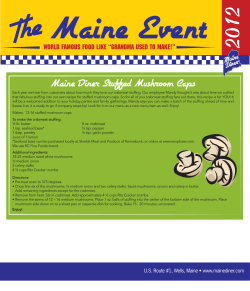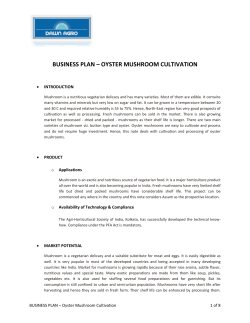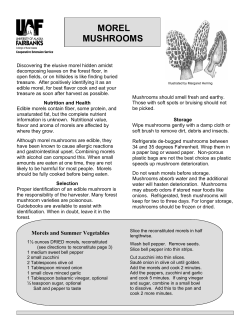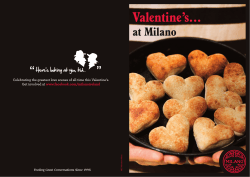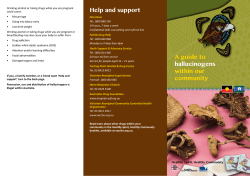
T On Eating Raw Mushrooms MUSHROOM DAY 2009
LONG ISLAND MYCOLOGICAL CLUB http://limyco.org VOLUME 17, NUMBER 3, AUTUMN, 2009 MUSHROOM DAY 2009 PLANTING FIELDS ARBORETUM OCT. 25 1 PM—4 PM MUSHROOM DAY 2004 Autumn is soon upon us, and with it our annual public mushroom exhibit at Planting Fields Arboretum, Oyster Bay. Please join us to celebrate the acme of the mushroom year. The public display will run from 1 to 4 PM, but if you wish to assist, arrive around 12 noon to help in setting up the exhibit. Remember that the entrance fee now applies to LIMC members also. Bring any interesting specimens that you find for exhibition and identification. (You do not need to identify them yourself.) 2007’s exhibit was cancelled, for the first time in our history, due to adverse conditions. If dry weather descends again, we will need everyone’s participation to make this year’s a success. On Eating Raw Mushrooms From “The Mycena News”, San Francisco Mycological Society, November 2008, by David Campbell (reprinted by permission of the author) T here seems to be an ongoing temptation amongst mycophagists and chefs to serve mushrooms raw or barely cooked. Generally speaking, this is not the best of ideas. The mycochitin of mushroom cell walls is difficult for humans to digest. Our stomachs resent indigestible items, and often forcibly reject them without further ado. The cooking process helps break down fungal cell walls, rendering mushroom flesh not only more readily digestible, but also releasing significant nutritional value contained within the cells. Further, many mushrooms considered edible contain irritating or toxic components readily destroyed or eliminated by cooking. Therefore, common and valid mycophageal wisdom dictates that all edible mushrooms should be cooked prior to consumption. Exceptions are made only if one has specific knowledge that a particular pristine species is safe to eat raw. With these few au naturel exceptions, the “pristine” part becomes especially important. Environmental or microbial contaminations to the mushroom flesh may pose potential health hazards. By dramatic example, a few free-spirited youths in Hawaii a few years ago blithely consumed blue-staining Psilocybes as they went collecting from cow patties. What a downer it must have been a short while later, when the doctor told them they had nematodes! Bear in mind, there is much yet to be learned about eating mushrooms; wild or tame, cooked or raw…the research is in progress, and we the mycophagists are, by default, the guinea pigs. What we know of mushroom edibility is primarily the result of shared anecdotal information, as compiled and recorded over the course of human history. Hardly do we rest on hard science or a complete body of knowledge when we decide whether or not to eat a given fungus. In fact, another good general reason for cooking one’s mushrooms is the blind stab it represents at protecting us from the unknown. The list of edible mushrooms considered safe for raw con(Continued on page 6) 2 LI SPOREPRINT PRESIDENT'S MESSAGE After an unforgettable summer (it was so bad, how could you forget?) Fall is here. We have now started to find chicken-of-the-woods and Leccinum in our area. There are reports that hen-ofthe-woods is also being found. Joel and I took a four mile walk recently in Brookhaven S.P. (see page 3) and found about 15 different mushrooms., some quite interesting, and one new bolete, B. auriflammeus. I suggest anyone who can, get out and look around. You might just find something new and also enjoy nature. Here’s to keeping a good thought! (One good thing about this year is that we continue to add new species to our list. When you rejoin for next year, you’ll receive an updated list. It keeps getting longer and longer.) There has been a change in date for our annual luncheon. It will be on Sunday, November 8th, 2009. Mailings for the luncheon will go out in early October. If anyone has some mushroom related items, old or new, to donate for the raffle, please let me know. Thank you Cathy Cresko for your donations. It really helps me out. It gets harder and harder each year to find inexpensive things. Please make an effort to attend. This is really our only purely social gathering and its good to meet new and old friends. (Speaking of friends, a special greeting to John and Lena. We miss you! Also to Erich Schulz...hope you are getting better.) In closing, I do hope you are all well and enjoying this fine fall weather. Hope to see you along the way. EDITOR’S NOTE Amateur mycology differs from all other natural history studies in that consumption of the object studied usually forms an essential part of the pursuit for most collectors, in contrast to, say, birding or mineralogy, . Consequently, issues of edibility and toxicity must be addressed, although usually with a lesser focus than identification. That is, a mushroomer can explain more easily how to identify a specimen than to enumerate the chemical reasons for its edibility or lack of it. The lead article in this issue addresses this question, enumerating the precise rationale for avoiding raw mushroom consumption, and your editor has added some additional facts re the positives and negatives of prepared mushroom ingestion. As in most areas of life, the watchword is moderation. Those who seek excitement or novelty would be well advised to do so in realms other than mycophagy. Or to do so with new recipes using proven ingredients rather than untested species. In other words, when it comes to new species, “Snag it, bag it, and tag it” but don't scarf it. MATERIAL FOR THE WINTER, 2009 EDITION SHOULD REACH THE EDITOR BY NOVEMBER 30TH (Submissions can be forwarded by email in any format or may be typed.) LI Sporeprint is published quarterly. Material herein may be freely copied by any non-profit organization if appropriate acknowledgements are made and a copy supplied to the editor. LONG ISLAND MYCOLOGICAL CLUB President:Peggy Horman Treasurer & Membership Secretary: Peggy Horman (631) 744-4965 e-mail: owls2@optonline.net Recording Secretary: Monique Dussault Foray Chairman: Jacques Brochard Species Recorder: Bruce Eberle Webmaster: Dale Robins Science Adviser: Benjamin Wolfe, PhD cand. Sporeprint Editor: Joel Horman 11Ramblewood Rd., Ridge, NY 11961 Tel: (631) 744-4965 e-mail: jlhorman@optonline.net Editorial Ass’t: Peggy Horman Board Members: Rita Blinderman, Cathy Cresko, Tony Mish, Roger Eklund Leonard Schecter. 3 AUTUMN, 2009 BROOKHAVEN STATE PARK (UNOFFICIAL) OPENING LIMC members may not realize it, but they are already familiar with Brookhaven State Park, in whose northern reaches autumn forays have taken place for a good number of years. But this entry point is unmarked and accessed through the Shoreham/ Wading River High School Library parking lot. Since the border of Pitch Pines surrounding the adjacent army base was cut down several years ago, apparently for “homeland security” purposes, our harvests there have diminished. So it is timely that this park, originally part of the nearby Brookhaven National Lab property, which has remained in an “unimproved condition” since 1971, has now increased its public access. Above is a photo of what is now the main entrance on William Floyd Highway’s east side, just past the light at Whiskey Road. In the past, those in the know parked on the side of the highway to gain entrance, but now a parking lot has been designated inside the park, directly past the entrance. It will remain open Friday through Sunday beginning immediately, but only from 8 AM to 3 PM. Readying the park for its public debut has, for the past five years, been the primary task of Park Supervisor Jim Mesenbourg, shown here with his assistant Hernando erecting an informational kiosk. This challenging task has involved improving the roads, rebuilding the picnic shelters, controlling invasives, building barriers to prevent ATV entry, etc, over this 2300 acre pine-oak woodland. Regular patrols have also been successful in discouraging poaching and illegal off-road vehicles. Jim is a passionate admirer of natural history and is mushroomer friendly. As he points out, it is almost miraculous that in this difficult economic time of budget contraction this park opening could take place. Not much publicity has been given to this event, in order to gauge the reaction to this limited opening. It is a good place for mushrooms, and we hope to schedule some Jim (right) & assistant Hernando forays there next autumn. Serendipitously, on the very day that I interviewed Jim, I collected there the rare species discussed in the article below. FINDINGS AFIELD On Aug. 28, in the midst of a dry spell, I encountered this impressive Amanita, which at first glance I took for an oversized A. onusta, only to be happily dissuaded when I saw the color of the gills, an attractive “café au lait”, as Rod Tulloss describes it. There are only two species in subsection Lepidella which have this color, the other being A. pelioma, which bruises blue-green, which this did not. The partially opened cap was 14.5 cm wide, at the upper limits of this species, and covered with pointed, gray-brown pyramidal warts. A slight chlorine-like odor was preent. The annulus was concolorous with the cap, and lighter than the gills. Stipe about 24 cm long, the basal bulb somewhat rooting. Spores amyloid, 10-12 X 5.57 µm, broadly ellipsoid, slightly longer than reported. This mushroom has a southern distribution, from NJ south to Texas and into Mexico, but no NY records that I could find, although the type was found by Bas in Amanita microlepis Massachusetts in 1969. In the NY/NJ area, found in only one site in Mercer Co. (R. Tulloss-pers.comm ) Amanita microlepis will be the newest addition to the LIMC checklist. LI SPOREPRINT 4 FORAY RESULTS SUMMARY JUNE 20, CHRISTIE: 25 species, with some early arrivals such as Hypholoma fasciculare, and Suillus granulatus. JULY 4, MUTTONTOWN EQUESTRIAN: 24 species, no genus dominating. The first bolete of the season, Boletus affinis and one new to the list, Marasmiellus nigripes, identified on sight by Aaron, who also did the honors for this day’s list. JULY 11, HECKSCHER S.P. 35 species, with Russulaceae dominant (6 Lactarius and 8 Russula), some Chanterelles, and a fair number of Black Trumpet. One new species, Inocybe ventricosa, and one unaccountably previously overlooked, Peziza badia. JULY 18, WEST HILLS SOUTH: A total of 48 species, Russulaceae again dominating with 14 species of Russula and 5 of Lactarius. There were 3 species of chanterelles: cibarius, cinnabarinus, and ignicolor. The glistening Coltrichia cinnamomea decorated every nook, and a lurid Gyroporus cyanescens astounded newcomers with its indigo staining reaction. The rare Inocybe tubaroides, always on wood, was also encountered. JULY 25, BETHPAGE S.P: Very similar results to the last foray, with 44 species, many in common, and also few boletes, including B.griseus ,B.subvelutipes, about par for this season, which has been bolete deprived. AUGUST 1, MUTTONTOWN NORTH: 36 species, with now reduced numbers of Russula & Lactarius. Collybia (Gymnopus) dichrous was very prominent everywhere throughout the forest, followed by C. subnuda. SEPT. 12, CALEB SMITH: (All previous scheduled forays cancelled due to dry weather.) 42 species, gathered in the rain, was a good total following the dry spell, and we thank all participants for venturing out. Among edibles, a good amount of Ringless Honeys (Armillaria tabescens) were gathered, one small Sulphur Shelf, and a few Lactarius hygrophoroides. The leaf litter was sprinkled with a myriad of Marasmius capillaries, their tiny white caps sparkling in the gloom. BOOK REVIEW CORNER The “Field Guide to N.A. Truffles: Hunting, Identifying, and Enjoying the World’s Most Prized Fungi” by Matt Trappe, Frank Evans, and James Trappe is North America’s first field guide to these elusive subterranean fungi. Although the subtitle is a little misleading, since none of the world’s most prized fungi occur in North America, the contents of this little gem are comprehensive, illuminating, and well worth the price (less than $12 on Amazon). The doyen of trufflelogy is James Trappe, who has published over 400 scientific papers and described 34 new genera and 144 new species of the truffle family, many in Australia. His son Matt is Trufflemaster of NATS, the N.A. Truffling Society and a PhD candidate at Oregon S.U. Frank Evans is one of the founding members of NATS and a retired engineer. Prior to the publication of this book, all that was available was a series of flash cards sold by NATS. The book profiles 90 species of truffles, edible and inedible, organized alphabetically, with one species per page, each with a sharp color photograph of its exterior and interior, and a smaller microphotograph of the spore, with its measurement given in the text. Succinct data regarding season, distribution, habitat, and edibility are provided, along with a DR– a desirability rating enlightening us as to whether an edible species is insipid, palatable, tasty or delicious. Differentiation as to group is also given, and it is fascinating to see truffles that are members of the Bolete or Russula family. LIMC members will be interested to hear that Rhizopogon rubescens, common in the pine barrens, is edible but merely palatable. Who will be the first among us to brave this novel fungus? Truffle recipes can be found on the NATS website, where one can also find what is sorely missing from the book, a key to the species of truffles under consideration.. http://www.natruffle.org AUTUMN, 2009 5 ■RESHUFFLING SULPHUR-SHELF: Japanese researchers, on the basis of DNA and incompatibility studies have demonstrated the occurrence of three taxa of Laetiporus, none equivalent to N.A. species. Previously, two species and one variety were reported, one of which, L. versiporus was shown to be an anamorph (asexual) form of L. sulphureus v. sulphureus auct. jap. The findings suggested that hybridization was ongoing in the “sulfurous/versiporus” group. This may encourage researchers in the U.S. to take a closer look at the various morphological forms in the northeast which appear to display characteristics of both L. sulphureus and L. cincinnatus. ( “Relationships among three Japanese Laetiporus, etc”.,Mycoscience, 2008,49:168-177) ■ TOO MUCH OF A GOOD THING? A Finnish study has documented the presence of creatine kinase, (a chemical associated with previous fatal wild mushroom intoxication and rhabdomyolysis by Tricholoma equestre) in several genera of commonly consumed wild edibles including Russula spp., Cantherellus cibarius, Albatrellus ovinus, and Leccinum. Various amounts of these wild mushroom was added in powder form to the food intake of mice for 5 days, after which they were sacrificed. All mushroom species used caused changes associated with toxicity in the group consuming the highest amount, 9g/kg body mass per day, which is the human equivalent of about 3.7-12.8 oz for a 154 lb. person (when corrected for surface/weight ratio). They conclude that myotoxic effects are not limited to one or two species but are widespread in otherwise edible wild fungi, and that cultivated mushrooms should also be examined for this phenomena. An interesting side note was that Russula spp. caused these changes at the very lowest amounts. (“Suspected Myotoxicity of Edible Wild Mushrooms”, P. Nieminen et al, Exp Biol Med 231, 2006) ■ MYCOTOXIN IDENTIFIED: While the above study did not identify the cause of the rhabdomyolisis effect, a more recent study utilizing the known toxic Japanese mushroom Russula subnigricans, one of the blackening Russulas, was successful in isolating the toxin. Using R. subnigricans collected in the Kyoto region, where several poisonings had taken place, a small 4-carbon molecule known as cycloprop-2ene carboxylic acid was identified which was lethal when administered to mice, as were the mushrooms themselves.(Consumption by humans causes convulsions, nausea, impaired speech, and sometimes death.) The next logical step would be to identify and isolate this substance from known edible rather than toxic species. (Identification of the toxic trigger in mushroom poisoning. Nature Chemical Biology. Hashimoto et al. Publishshed online: 24 May 2009. Reprinted online in Science News, 6-20-09, Vol. 175 #13) (Compiled by editor from indicated sources.) Great Goddess of Decay! - A History of Amateur Mycology in the United States Presented by David W. Rose, archivist, writer, and past president of the ConnecticutWestchester Mycological Association. This illustrated talk focuses on the role of amateurs in advancing the science of mycology in the U.S. Beginning in the 1890's, popular interest in mushrooms was stimulated by mycology clubs that began to form in cities on the East coast. Prominent professionals like Charles Horton Peck of the New York State Museum and William Murrill of the New York Botanical Garden, and amateurs like Charles McIlvaine, published illustrated works on the fungi; by the twentieth century the study of mushrooms became fixed as a popular adjunct of botany. By midcentury, amateur mycology was re-invigorated by Robert Gordon Wasson's discovery of a mushroom cult among the Mazatecs in Oaxaca, Mexico. Soon after, the North American Mycological Association was formed, enlisting the help of noted composer John Cage in promoting the study of mushrooms. This talk will trace the history of amateur mycology, the interactions between amateurs and professionals, and the place of mycology in American society from the 1890s to the present day. To be presented Tuesday, October 6, 2009, 6:30 PM at the Arthur and Janet Ross Lecture Hall, The New York Botanical Garden, 200th Street and Kazimiroff Blvd, Bronx, NY 10458 A schedule of the Torrey Botanical Lectures is available upon request from your editor. (Information courtesy Dr. Andrew Greller) LI SPOREPRINT Eating Raw Mushrooms 6 (Cont’d from page 1) sumption is quite short. Even species commonly eaten raw, especially the ubiquitous button mushroom, Agaricus bisporus, have their drawbacks. Buttons, and many other edible mushrooms contain various hydrazines, a group of chemical compounds generally considered carcinogenic. For the most part, these compounds are heat sensitive, readily volatilized and expunged from the fungal flesh by proper cooking. This basic understanding is employed by some more adventurous to justify eating the false morel, Gyromitra esculenta, a deadly poisonous species. Those who so indulge in this behaviour believe the hydrazine compounds present (naturally occurring gyromitrin converts to monomethylhydrazine, or MMH when heated) to be effectively removed, at least to a large degree, by thorough cooking, provided one stands well clear of the fumes during the cooking process. The more conservative mycophagists consider this practice questionable, at best, and argue that gyromitrin is never completely eliminated, that there may well be harmful cumulative factors associated with repeat false morel consumption….I say, “To each his own,” in decisions such as this, cautioning only that the innocent and unaware should never be arbitrarily included in mycophageal experimentation. The kicker with Agaricus species, including the buttons, is that one of their primary hydrazine components, along with gyromitrin, is “agaritine,” a substance somewhat resistant to cooking heat, with a significant percentage (25–75%) of agaratine material typically remaining after being subjected to various methods of cooking. So, the question as far as avoiding hydrazines in Agaricus is concerned, actually becomes whether to eat members of this genus at all. We need to keep in mind that lab tests and subsequent conclusions drawn concerning carcinogenic or mutagenic health hazards of hydrazine involve massive doses of isolated extracts administered to mice in a concentrated time frame.* Similarly disturbing test results are likely to be found with many substances present in many, many foods humans commonly eat without suffering or even worrying about any particular health concern. The relatively unblemished human history of consuming edible Agaricus species suggests we may continue to do so. The science may suggest we should not over indulge, but we already knew that. As I know of no one stricken by cancer or any other malady as particular result of eating Agaricus, and since the genus includes some of the most delectable of all edibles, there are several wild Agaricus species that remain firmly ensconced on my preferred edibles list. Unfortunately, the button mushroom industry routinely promotes the use of their product raw, especially on salads, perpetuating the myth that mushrooms need not be cooked. I presume such promotion to be a profit driven policy. A recent Poison Control Center response incident with Gyromitra montanum purchased at a Whole Foods store demonstrated the broader danger of public misconception about the safety of eating store-bought mushrooms raw. The blithe and unwitting basic understanding is employed by some more adventurous mycophagists to justify eating the false morel, Gyromitra esculenta, a deadly poisonous mushroom according to every published description I’ve read. Those who so indulge in this “victim” reportedly took a nice chomp from her just purchased bull’s nose as she walked out of the store! As far as I know, this mushroom contains hydrazine compounds that may be quite similar to those found in Gyromitra esculenta, but in sufficiently reduced concentrations to be listed in many published mushroom guides as edible, if cooked. In this case, the immediate effects induced by consumption of the raw Gyromitra flesh easily trumped any long-term health concerns. Cooking of mushrooms generally reduces the likelihood of gastro-intestinal irritation, and allergenic reaction. Popular comestibles such as morels (Morchella sp.), hedgehogs (Hydnum repandum) and oyster mushrooms (Pleurotus sp.) will almost certainly make one ill if eaten raw. Chanterelles (Cantharellus cibarius, formosus, etc.) are generally considered stomach irritants in the raw. King boletes (Boletus edulis) are known to cause many people gastro disturbance even when cooked, but are nonetheless popular raw in the hard-button stage. Diners served a raw porcini salad are well advised to eat just a tat…or else. Some small and/or gooey mushrooms are often eaten raw, mostly because they hardly lend themselves to cooking. The witch’s butters (Tremella mesenterica, T. foliacea, Dacromyces palmatus) and toothed jellies (Pseudohydnum gelatinosum, Phlogiotis hellvelloides) are good examples of fungi commonly eaten “as is,” sans ill reported effect, or at least I’ve heard no dire reports. Part of the safety in occasionally consuming oddball species such as these is we never really eat all that much. In fact, the key to safe consumption of any and all mushrooms, aside from proper ID and sufficient cooking, is moderation. Somewhat ironically, given the nefarious reputation of the genus at large, the most readily di(Continued on page 7) AUTUMN, 2009 Eating Raw Mushrooms 7 (Continued from page 6) gestible, or at least most innocuous, mushroom to eat raw, by my experience, is the coccoli (Amanita lanei). I generally eat these mushrooms raw because they so remind me of oysters (mollusks, not the fungus), in that the more you cook them, the less desirable they become. In all fairness, I should mention that I do chemically cook my coccoli salad with lemon juice marinade…I have never suffered any discomfort, nor have I heard complaints from those who have consumed my “coccoli ceviche.” Of course, you are not likely to see edible Amanita specimens for sale in the market, nor should you, methinks. Our markets and the public both lack the knowledge and sophistication to safely trade a product so easily confused with its lethal cousins! Other methods of chemical cooking, aside from citric acid, involve brining or pickling. I lack personal experience with this form of mushroom processing, but I have heard and read it is used to apparently satisfactory effect in many cultures, notably Russia, where many kinds of freshly collected Russula and Lactarius species are reportedly tossed collectively into the brine barrel, to be directly retrieved and munched later. Of interest with this method is that some of these species so prepared are *EDITOR’S COMMENTS: Although some animal research involves administration of agaratine and similar compounds directly, there is a great body of experimentation using raw and cooked mushrooms (mailnly Agaricus) in small amounts over an extended time period. These are well summarized in the 1996 “Nordic Seminar: Phenylhydrazines in the Cultivated Mushroom (Agaricus bisporus)”, the full text of which is available online by doing a title search. Their estimate of the lifetime cancer risk in humans, based on results of 6 studies, is that a normal (4 g per day) consumption of A. bisporus results in 2 cases of cancer per 100,000 population. Risk varies with cooking methods (baking eliminates the least percentage) and amount consumed, but the uncertainties of many factors make the precise carcinogenic potential difficult to assess. Not mentioned in the above work is the possible offsetting effect of consuming other species of mushrooms, such as Shitake, which have a demonstrated immune system enhancing effect. The study also does not treat the possible immediate toxic effects of large amounts of otherwise edible species, which has been demonstrated in animal studies with Boletus edulis, (See “Gleanings”, this issue) and has fa- considered poisonous when cooked by conventional heat application. As stated above, cooking with heat destroys many toxins and irritants found in mushrooms. Toxins present in various red- sponged species of the genus Boletus, for instance, may allegedly be neutralized with prolonged cooking. Ibotenic acid and related toxic compounds present in Amanita muscaria are not heat-sensitive, but are soluble in boiling water. This mushroom may be rendered edible by properly leaching the mushroom toxins into boiling water, tossing the water, and eating what’s left of the mushroom. I have been party to this process several times while participating in David Arora’s annual Mendocino seminars, where we often served properly processed fly agaric, sliced and boiled, to the assembled throng, free from toxic effect. Make no mistake, however. Deadly amanitin toxins present in the death cap and destroying angel (Amanita phalloides, A. ocreata, etc.) are oblivious to heat and leaching processes, retaining their virulent properties regardless of cooking methods applied. Cooking or not makes no difference with these toadstools; they remain fully capable of killing any sad soul who egregiously partakes, regardless. mously been known to occur in humans with Tricholoma equestre, which caused several deaths. With this in mind, David Campell is correct to emphasize moderation in the consumption of mushrooms. It should be remembered that when news of the T. equestre poisoning panicked the world of mycophagy, the Canadian Health Service did not ban consumption but calmly urged mushroomers to ingest no more than 100 grams (about 3 ounces uncooked weight) of Tricholoma equestre per week. Paul Stamets, in his “Growing Gourmet and Medicinal Mushrooms” is disturbed that in the United States, up to 80% (his figures) of all commercial Agaricus consumed are eaten uncooked. Inasmuch as some cultivated strains have much lower agaratine content than others, he feels it is incumbent upon the mushroom industry to create a strain of agaritine-free mushrooms. With all these caveats, it should not be forgotten that mushrooms are a good source of protein and fiber, vitamins including D and K, low in fat and calories, with essential amino acids not found in vegetables, are coveted by knowledgeable gourmets worldwide, and are free to those willing to learn their secrets. Jean Paul Latil © IN THIS ISSUE Mushroom Day 2009 On Eating Raw Mushrooms President’s Message Editor’s Note Brookhaven S.P. Opening Findings Afield Foray Results Summary Book Review Corner Gleanings Upcoming Talk by David Rose 1 1 2 2 3 3 4 4 5 5 We acquire a true knowledge only of things that we are obliged to re-create by thought, things that are hidden from us in everyday life... Marcel Proust, “Remembrance of Things Past” LONG ISLAND MYCOLOGICAL CLUB 11 RAMBLEWOOD RD. RIDGE, NY 11961
© Copyright 2025


